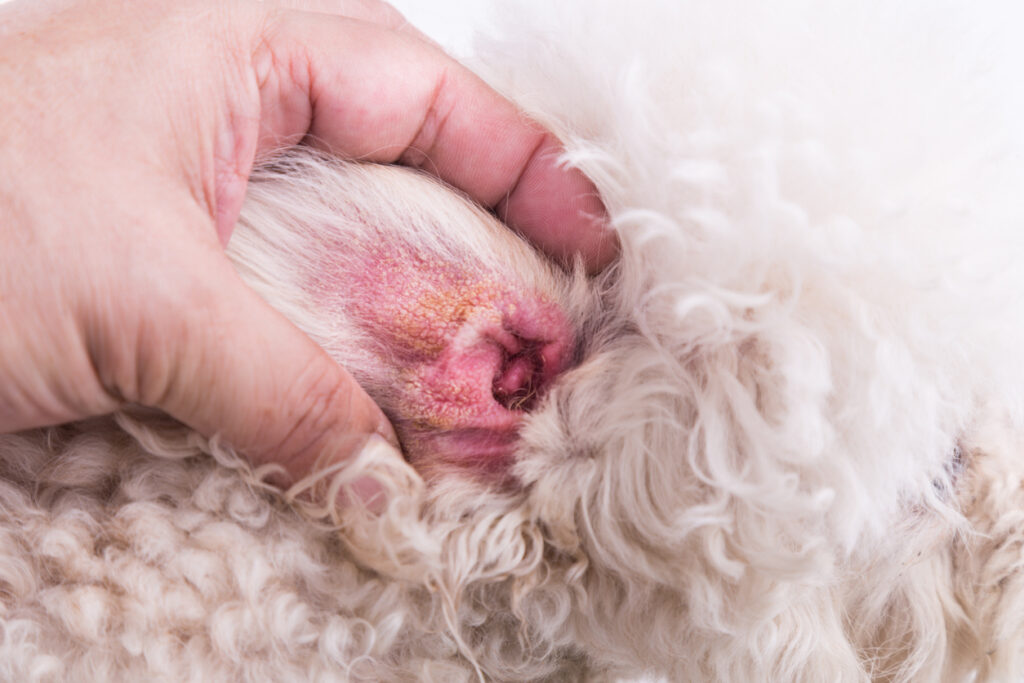What is Dog Ear Hematoma?
Dog ear hematoma is a relatively common condition that can affect dogs of all breeds and ages. It is characterized by the accumulation of blood between the skin and the cartilage of the ear flap (pinna), resulting in a swollen and painful ear. It is also known as aural hematoma. Canine ear hematoma is not life-threatening, but it can cause discomfort for dogs and complications if left untreated. It is mostly observed in dogs with droopy ears such as Cocker Spaniels, Basset Hounds, and Labrador Retrievers, but can occur in any breed. We will examine dog ear hematoma causes symptoms, diagnosis, treatment, and prevention in greater depth in this article.
Causes of Dog Ear Hematomas
Below are the most common reasons for dog ear hematomas.
Ear infections
Chronic ear infections can cause inflammation and discomfort in the ear, leading to scratching and shaking of the head vigorously, which can result in hematoma.
Trauma
Injuries to the ear, like being hit by a car, being scratched by another animal, or getting wedged on something, can cause hematoma.
Allergies
Allergies can cause inflammation and irritation in the ear, leading to scratching and shaking of the head, which can result in a hematoma.
Autoimmune diseases
Few autoimmune diseases can cause the body to harm the tissues of the ear, leading to inflammation and swelling.
Blood clotting disorders
Dogs with blood clotting disorders may be more prone to developing hematomas.
Symptoms of Dog Ear Hematomas
If you think your dog may have a hematoma, look for these symptoms.
Swelling of the ear flap
The ear flap (pinna) may seem swollen and thickened and might feel warm to the touch.
Pain or discomfort
Dogs who have ear hematoma could be constantly in pain or feel uncomfortable, they may also scratch and shake their head frequently.
Head shaking
Dogs with an ear hematoma may shake their head frequently as if trying to dislodge something from their ear.
Ear discharge
In some cases, there may be purulent discharge from the ear, which might be bloody or pus-like.
Redness or inflammation
The ear may appear red or inflamed, and the skin may be warm to the touch. In severe cases, the ear may become misshapen or even permanently damaged. It is essential to note that the symptoms of a dog’s ear hematoma can be like those of other ear conditions. So, it is important to have the dog examined by a veterinarian to determine the cause of the symptoms.
Diagnosis of Dog Ear Hematomas
To diagnose a dog’s ear hematoma, a veterinarian will typically perform a physical examination of the dog’s ear, including an inspection of the ear canal and surrounding tissues. The vet may also look for swelling, and redness around the ear as well as for any sign of pus discharge. In some cases, the vet may also perform some diagnostic lab tests to look for the main cause.
Ear cytology
A sample of the ear discharge is collected and examined under a microscope to test for the presence of bacteria, yeast, or other microorganisms.
Blood tests
Blood tests will help to identify underlying medical illnesses that may be aiding the hematoma, such as a blood clotting disorder.
Allergy testing
If allergies are suspected as a contributing factor, skin or blood tests may be performed to identify the specific allergens that are causing the problem.
Biopsy
In exceptional cases, a biopsy of the ear tissue is necessary to rule out more serious conditions such as cancer.

Treatment of Dog Ear Hematomas
The treatment of hematoma depends on the severity of the hematoma and the overall health condition of the dog. Both surgical and non-surgical treatments are applicable:
Surgical Treatment Options
- Incision and drainage: This involve making a very small incision in the ear to drain the blood that has accumulated, and to stop further bleeding, the skin is then sutured to the cartilage beneath.
- Hematoma repair surgery: To do this, a small incision is made in the ear to remove the bloody mass, and to stop further bleeding, sutures are used to attach the skin to the cartilage underlying. This approach may be preferred for larger or recurrent hematomas.
Non-surgical Treatment
- Drainage and bandaging: At first the accumulated blood in the ear is drained and then bandaging is done to prevent further bleeding. This strategy can be effective for smaller hematomas, but it may not be productive for larger hematomas.
- Medications: Anti-inflammatory medications, such as steroids or nonsteroidal anti-inflammatory drugs (NSAIDs), may be prescribed to help reduce swelling and pain.
Home remedies for ear hematoma
Apply a cold compress.
Put a cold compress, such as a cold pack or a bag of frozen peas, wrapped in a towel, over the affected ear. This can help reduce swelling and inflammation.
Use natural remedies.
Natural remedies like witch hazel or aloe vera can be applied topically to the affected ear to help soothe inflammation and promote healing.
Keep the ear clean and dry.
It’s important to keep the ear clean and dry to prevent infection. Use a clean, damp cloth to gently wipe away any discharge or debris from the affected ear.
E-collar
An Elizabethan collar, also known as an e-collar or cone, can be used to prevent your dog from scratching or rubbing the affected ear.
Prevention of Dog Ear Hematomas
Preventing dog ear hematomas can be achieved through regular grooming and ear care, including cleaning the ears, and trimming excess hair. This can help prevent the accumulation of dirt, debris, and moisture in the ear, which can contribute to the development of ear infections or scratching that can cause hematoma. Additionally, pet owners can help reduce the risk of trauma or injury to their dog’s ears by avoiding activities that may cause excessive head shaking, such as rough play or high-impact exercise.
Conclusion
In conclusion, dog ear hematoma is a condition that can cause discomfort and complications for dogs if left untreated. Early diagnosis and treatment are important to prevent permanent damage to the ear and to help manage the dog’s symptoms. Pet owners should take steps to prevent the development of ear hematomas through regular grooming and ear care, and by avoiding activities that may cause trauma or injury to the ears.
If you are looking for help with a possible dog ear hematoma in Memphis, TN, contact McGehee Clinic for Animals by calling 901-682-5684 today, or request an appointment online.




